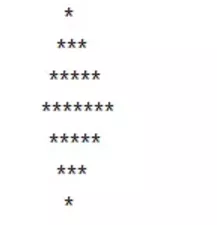
1. 已知一个字符串为 “hello_world_yoyo”,如何得到一个队列 [“hello”,”world”,”yoyo”] ?
使用 split 函数,分割字符串,并且将数据转换成列表类型:
test = 'hello_world_yoyo'
print(test.split("_"))
12
结果:
['hello', 'world', 'yoyo']
2. 有个列表 [“hello”, “world”, “yoyo”],如何把列表里面的字符串联起来,得到字符串 “hello_world_yoyo”?
使用 join 函数将数据转换成字符串:
test = ["hello", "world", "yoyo"]
print("_".join(test))
结果:
hello_world_yoyo如果不依赖 python 提供的 join 方法,还可以通过 for 循环,然后将字符串拼接,但是在用“+”连接字符串时,结果会生成新的对象,使用 join 时结果只是将原列表中的元素拼接起来,所以 join 效率比较高。
for 循环拼接如下:
test = ["hello", "world", "yoyo"]
# 定义一个空字符串
j = ''
# 通过 for 循环打印出列表中的数据
for i in test:
j = j + "_" + i
# 因为通过上面的字符串拼接,得到的数据是“_hello_world_yoyo”,前面会多一个下划线_,所以把这个下划线去掉
print(j.lstrip("_"))
3. 把字符串 s 中的每个空格替换成”%20”,输入:s = “We are happy.”,输出:“We%20are%20happy.”。
使用 replace 函数,替换字符换即可:
s = 'We are happy.'
print(s.replace(' ', '%20'))
12
结果:
We%20are%20happy.
4. Python 如何打印 99 乘法表?
for 循环打印:
for i in range(1, 10):
for j in range(1, i+1):
print('{}x{}={}\t'.format(j, i, i*j), end='')
print()
while 循环实现:
i = 1
while i <= 9:
j = 1
while j <= i:
print("%d*%d=%-2d"%(i,j,i*j),end = ' ') # %d: 整数的占位符,'-2'代表靠左对齐,两个占位符
j += 1
print()
i += 1
结果:
1x1=1
1x2=2 2x2=4
1x3=3 2x3=6 3x3=9
1x4=4 2x4=8 3x4=12 4x4=16
1x5=5 2x5=10 3x5=15 4x5=20 5x5=25
1x6=6 2x6=12 3x6=18 4x6=24 5x6=30 6x6=36
1x7=7 2x7=14 3x7=21 4x7=28 5x7=35 6x7=42 7x7=49
1x8=8 2x8=16 3x8=24 4x8=32 5x8=40 6x8=48 7x8=56 8x8=64
1x9=9 2x9=18 3x9=27 4x9=36 5x9=45 6x9=54 7x9=63 8x9=72 9x9=81
5. 从下标 0 开始索引,找出单词 “welcome” 在字符串“Hello, welcome to my world.” 中出现的位置,找不到返回 -1。
def test():
message = 'Hello, welcome to my world.'
world = 'welcome'
if world in message:
return message.find(world)
else:
return -1
print(test())
结果:
76. 统计字符串“Hello, welcome to my world.” 中字母 w 出现的次数。
def test():
message = 'Hello, welcome to my world.'
# 计数
num = 0
# for 循环 message
for i in message:
# 判断如果 ‘w’ 字符串在 message 中,则 num +1
if 'w' in i:
num += 1
return num
print(test())
# 结果
2
7. 输入一个字符串 str,输出第 m 个只出现过 n 次的字符,如在字符串 gbgkkdehh 中,找出第 2 个只出现 1 次的字符,输出结果:d
def test(str_test, num, counts):
"""
:param str_test: 字符串
:param num: 字符串出现的次数
:param count: 字符串第几次出现的次数
:return:
"""
# 定义一个空数组,存放逻辑处理后的数据
list = []
# for循环字符串的数据
for i in str_test:
# 使用 count 函数,统计出所有字符串出现的次数
count = str_test.count(i, 0, len(str_test))
# 判断字符串出现的次数与设置的counts的次数相同,则将数据存放在list数组中
if count == num:
list.append(i)
# 返回第n次出现的字符串
return list[counts-1]
print(test('gbgkkdehh', 1, 2))
结果:
d
8. 判断字符串 a = “welcome to my world” 是否包含单词 b = “world”,包含返回 True,不包含返回 False。
def test():
message = 'welcome to my world'
world = 'world'
if world in message:
return True
return False
print(test())
结果:
True
9. 从 0 开始计数,输出指定字符串
def test():
message = 'hi how are you hello world, hello yoyo!'
world = 'hello'
return message.find(world)
print(test())
结果:
15
10. 从 0 开始计数,输出指定字符串 A = “hello”在字符串 B = “hi how are you hello world, hello yoyo!”中最后出现的位置,如果 B 中不包含 A,则输出 -1。
def test(string, str):
# 定义 last_position 初始值为 -1
last_position = -1
while True:
position = string.find(str, last_position+1)
if position == -1:
return last_position
last_position = position
print(test('hi how are you hello world, hello yoyo!', 'hello'))
结果:
28
11. 给定一个数 a,判断一个数字是否为奇数或偶数。
while True:
try:
# 判断输入是否为整数
num = int(input('输入一个整数:'))
# 不是纯数字需要重新输入
except ValueError:
print("输入的不是整数!")
continue
if num % 2 == 0:
print('偶数')
else:
print('奇数')
break
结果:
输入一个整数:100
偶数
12. 输入一个姓名,判断是否姓王。
def test():
user_input = input("请输入您的姓名:")
if user_input[0] == '王':
return "用户姓王"
return "用户不姓王"
print(test())
结果:
请输入您的姓名:王总
用户姓王
13. 如何判断一个字符串是不是纯数字组成?
利用 Python 提供的类型转行,将用户输入的数据转换成浮点数类型,如果转换抛异常,则判断数字不是纯数字组成。
def test(num):
try:
return float(num)
except ValueError:
return "请输入数字"
print(test('133w3'))
14. 将字符串 a = “This is string example….wow!” 全部转成大写,字符串 b = “Welcome To My World” 全部转成小写。
a = 'This is string example….wow!'
b = 'Welcome To My World'
print(a.upper())
print(b.lower())
15. 将字符串 a = “ welcome to my world ”首尾空格去掉
Python 提供了strip() 方法,可以去除首尾空格,rstrip() 去掉尾部空格,lstrip() 去掉首部空格,replace(" ", “”) 去掉全部空格。
a = ' welcome to my world '
print(a.strip())
还可以通过递归的方式实现:
def trim(s):
flag = 0
if s[:1]==' ':
s = s[1:]
flag = 1
if s[-1:] == ' ':
s = s[:-1]
flag = 1
if flag==1:
return trim(s)
else:
return s
print(trim(' Hello world! '))
通过 while 循环实现:
def trim(s):
while(True):
flag = 0
if s[:1]==' ':
s = s[1:]
flag = 1
if s[-1:] == ' ':
s = s[:-1]
flag = 1
if flag==0:
break
return s
print(trim(' Hello world! '))
16. 将字符串 s = “ajldjlajfdljfddd”,去重并从小到大排序输出”adfjl”。
def test():
s = 'ajldjlajfdljfddd'
# 定义一个数组存放数据
str_list = []
# for循环s字符串中的数据,然后将数据加入数组中
for i in s:
# 判断如果数组中已经存在这个字符串,则将字符串移除,加入新的字符串
if i in str_list:
str_list.remove(i)
str_list.append(i)
# 使用 sorted 方法,对字母进行排序
a = sorted(str_list)
# sorted方法返回的是一个列表,这边将列表数据转换成字符串
return "".join(a)
print(test())
结果:
adfjl
17. 打印出如下图案(菱形):

def test():
n = 8
for i in range(-int(n/2), int(n/2) + 1):
print(" "*abs(i), "*"*abs(n-abs(i)*2))
print(test())
结果:
**
****
******
********
******
****
**
18. 给一个不多于 5 位的正整数(如 a = 12346),求它是几位数和逆序打印出各位数字。
class Test:
# 计算数字的位数
def test_num(self, num):
try:
# 定义一个 length 的变量,来计算数字的长度
length = 0
while num != 0:
# 判断当 num 不为 0 的时候,则每次都除以10取整
length += 1
num = int(num) // 10
if length > 5:
return "请输入正确的数字"
return length
except ValueError:
return "请输入正确的数字"
# 逆序打印出个位数
def test_sorted(self, num):
if self.test_num(num) != "请输入正确的数字":
# 逆序打印出数字
sorted_num = num[::-1]
# 返回逆序的个位数
return sorted_num[-1]
print(Test().test_sorted('12346'))
结果:
1
19. 如果一个 3 位数等于其各位数字的立方和,则称这个数为水仙花数。例如:153 = 13 + 53 + 33,因此 153 就是一个水仙花数。那么如何求 1000 以内的水仙花数(3 位数)。
def test():
for num in range(100, 1000):
i = num // 100
j = num // 10 % 10
k = num % 10
if i ** 3 + j ** 3 + k ** 3 == num:
print(str(num) + "是水仙花数")
test()
20. 求 1+2+3…+100 相加的和。
i = 1
for j in range(101):
i = j + i
print(i)
结果:
5051
21. 计算 1-2+3-4+5-…-100 的值。
def test(sum_to):
# 定义一个初始值
sum_all = 0
# 循环想要计算的数据
for i in range(1, sum_to + 1):
sum_all += i * (-1) ** (1 + i)
return sum_all
if __name__ == '__main__':
result = test(sum_to=100)
print(result)
-50
22. 现有计算公式 13 + 23 + 33 + 43 + …….+ n3,如何实现:当输入 n = 5 时,输出 225(对应的公式 : 13 + 23 + 33 + 43 + 53 = 225)。
def test(n):
sum = 0
for i in range(1, n+1):
sum += i*10+i
return sum
print(test(5))
结果:
225
23. 已知 a 的值为“hello”,b 的值为“world”,如何交换 a 和 b 的值,得到 a 的值为“world”,b 的值为”hello”?
a = 'hello'
b = 'world'
c = a
a = b
b = c
print(a, b)
24. 如何判断一个数组是对称数组?
例如 [1,2,0,2,1],[1,2,3,3,2,1],这样的数组都是对称数组。用 Python 判断,是对称数组打印 True,不是打印 False。
def test():
x = [1, 'a', 0, '2', 0, 'a', 1]
# 通过下标的形式,将字符串逆序进行比对
if x == x[::-1]:
return True
return False
print(test())
结果:
True
25. 如果有一个列表 a = [1,3,5,7,11],那么如何让它反转成 [11,7,5,3,1],并且取到奇数位值的数字 [1,5,11]?
def test():
a = [1, 3, 5, 7, 11]
# 逆序打印数组中的数据
print(a[::-1])
# 定义一个计数的变量
count = 0
for i in a:
# 判断每循环列表中的一个数据,则计数器中会 +1
count += 1
# 如果计数器为奇数,则打印出来
if count % 2 != 0:
print(i)
test()
结果:
[11, 7, 5, 3, 1]
1
5
11
26. 对列表 a = [1, 6, 8, 11, 9, 1, 8, 6, 8, 7, 8] 中的数字从小到大排序。
a = [1, 6, 8, 11, 9, 1, 8, 6, 8, 7, 8]
print(sorted(a))
结果:
[1, 1, 6, 6, 7, 8, 8, 8, 8, 9, 11]
27. 找出列表 L1 = [1, 2, 3, 11, 2, 5, 3, 2, 5, 33, 88] 中最大值和最小值。
L1 = [1, 2, 3, 11, 2, 5, 3, 2, 5, 33, 88]
print(max(L1))
print(min(L1))
结果:
88
1
上面是通过 Python 自带的函数实现,如下,可以自己写一个计算程序:
class Test(object):
def __init__(self):
# 测试的列表数据
self.L1 = [1, 2, 3, 11, 2, 5, 3, 2, 5, 33, 88]
# 从列表中取第一个值,对于数据大小比对
self.num = self.L1[0]
def test_small_num(self, count):
"""
:param count: count为 1,则表示计算最大值,为 2 时,表示最小值
:return:
"""
# for 循环查询列表中的数据
for i in self.L1:
if count == 1:
# 循环判断当数组中的数据比初始值小,则将初始值替换
if i > self.num:
self.num = i
elif count == 2:
if i < self.num:
self.num = i
elif count != 1 or count != 2:
return "请输入正确的数据"
return self.num
print(Test().test_small_num(1))
print(Test().test_small_num(2))
结果:
88
1
28. 找出列表 a = [“hello”, “world”, “yoyo”, “congratulations”] 中单词最长的一个。
def test():
a = ["hello", "world", "yoyo", "congratulations"]
# 统计数组中第一个值的长度
length = len(a[0])
for i in a:
# 循环数组中的数据,当数组中的数据比初始值length中的值长,则替换掉length的默认值
if len(i) > length:
length = i
return length
print(test())
结果:
congratulations
29. 取出列表 L1 = [1, 2, 3, 11, 2, 5, 3, 2, 5, 33, 88] 中最大的三个值。
def test():
L1 = [1, 2, 3, 11, 2, 5, 3, 2, 5, 33, 88]
return sorted(L1)[:3]
print(test())
结果:
[1, 2, 2]
30. 把列表 a = [1, -6, 2, -5, 9, 4, 20, -3] 中的数字绝对值。
def test():
a = [1, -6, 2, -5, 9, 4, 20, -3]
# 定义一个数组,存放处理后的绝对值数据
lists = []
for i in a:
# 使用 abs() 方法处理绝对值
lists.append(abs(i))
return lists
print(test())
结果:
[1, 6, 2, 5, 9, 4, 20, 3]

































